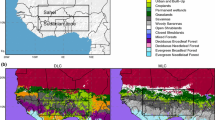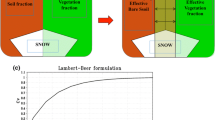Abstract
Vegetation is known to interact with the other components of the climate system over a wide range of timescales. Some of these interactions are now being taken into account in models for climate prediction. This study is an attempt to describe and quantify the climate–vegetation coupling at the interannual timescale, simulated with a General Circulation Model (HadSM3) coupled to a dynamic global vegetation model (TRIFFID). Vegetation variability is generally strongest in semi-arid areas, where it is driven by precipitation variability. The impact of vegetation variability on climate is analysed by using multivariate regressions of boundary layer fluxes and properties, with respect to soil moisture and vegetation fraction. Dynamic vegetation is found to significantly increase the variance in the surface sensible and latent heat fluxes. Vegetation growth always causes evapotranspiration to increase, but its impact on sensible heat is less straightforward. The feedback of vegetation on sensible heat is positive in Australia, but negative in the Sahel and in India. The sign of the feedback depends on the competing influences, at the gridpoint scale, of the turbulent heat exchange coefficient and the surface (stomatal) water conductance, which both increase with vegetation growth. The impact of vegetation variability on boundary layer potential temperature and relative humidity are shown to be small, implying that precipitation persistence is not strongly modified by vegetation dynamics in this model. We discuss how these model results may improve our knowledge of vegetation–atmosphere interactions and help us to target future model developments.







Similar content being viewed by others
References
Asner GP, Scurlock JMO, Hicke JA (2003) Global synthesis of leaf area index observations: implications for ecological and remote sensing studies. Global Ecol Biogeogr 12:191–205
Aussenac G (2000) Interactions between forest stands and microclimate: ecophysiological aspects and consequences for silviculture. Ann Forest Sci 57:287–301
Charney JG (1975) Dynamics of deserts and drought in Sahel. QJR Met Soc 101:193–202
Claussen M, Kubatzki C, Brovkin V, Ganopolski A (1999) Simulation of an abrupt change in Saharian vegetation in the mid-Holocene. Geophys Res Lett 26:2037–2040
Cox PM (2001) Description of the TRIFFID dynamic global vegetation model. Technical Note 24, Hadley Centre, Met Office, Exeter, UK
Cox PM, Huntingford C, Harding RJ (1998) A canopy conductance and photosynthesis model for use in a GCM land surface scheme. J Hydrol 212–213:79–94
Cox PM, Betts RA, Bunton CB, Essery RLH, Rowntree PR, Smith J (1999) The impact of new land surface physics on the GCM simulation of climate and climate sensitivity. Clim Dyn 15:183–203
Cox PM, Betts RA, Jones CD, Spall SA, Totterdell IJ (2001) Modelling vegetation and the carbon cycle as interactive elements of the climate system. In: Pearce R (ed) Meteorology at the Millennium. Academic, New York, pp 259–279
Crucifix M, Betts RA, Hewitt CD (2005) Pre-industrial-potential and last glacial maximum global vegetation simulated with a coupled climate-biosphere model: diagnosis of bioclimatic relationships. Global Planet Change (in press) doi: 10.106/j.gloplacha.2004.10.001
Defries RS, Hansen MC, Townshend JRG (2000) Global continuous fields of vegetation characteristics: a linear mixture model applied to multi-year AVHHR data. Int J Remote Sensing 21:1389–1414
Eltahir EAB, Gong C (1996) Dynamics of wet and dry years in West Africa. J Clim 9:1030–1042
Essery RLH, Best MJ, Betts RA, Cox PM, Taylor CM (2003) Explicit representation of subgrid heterogeneity in a GCM land-surface scheme. J Hydromet 4:530–543
Folland C, Parker D, Palmer T (1986) Sahel rainfall and worldwide sea temperatures. Nature 320:602–607
Fuller DO, Ottke C (2002) Land cover, rainfall and land-surface albedo in West Africa. Clim Change 58:181–204
Garratt JR (1992) The atmospheric boundary layer. Cambridge University Press, Cambridge
Hewitt CD, Senior CA, Mitchell JFB (2001) The impact of dynamic sea-ice on the climatology and climate sensitivity of a GCM: a study of past, present, and future climates. Clim Dyn 17:655–668
Inness PM, Slingo JM, Woolnough SJ, Neale RB, Pope VD (2001) Organization of tropical convection in a GCM with varying vertical resolution; implications of the Madden-Julian oscillation. Clim Dyn 17:777–793
Karnieli A, Gabai A, Ichoku C, Zaady E, Shachak M (2002) Temporal dynamics of soil and vegetation spectral responses in a semi-arid environment. Int J Remote Sens 23:4073–4087
Koster RD, Dirmeyer PA, Guo Z, Bonan G, Chan E, Cox P, Gordon CT, Kanae S, Kozalczyk E, Lawrence D, Liu P, Lu C-H, Malyshev S, McAveney B, Mitchell K, Mocko D, Oki T, Oleson K, Pitman A, Sud YC, Taylor CM, Versghy D, Vasic R, Xue Y, Yamada T (2004) Regions of strong coupling between soil moisture and precipitation. Science 305:1138–1140
Lyons TJ, Schwerdtfeger P, Hacker JM, Foster IJ, Smith RCG, Huang X (1993) Land-atmosphere interaction in a semi-arid region: the bunny-fence experiment. Bull Am Meteorol Soc 74:1327–1334
Martin GM, Soman MK (2000) Effects of changing physical parametrisation on the simulation of the Asian summer monsoon in the UK Meteorological Office Unified Model, HCTN 17, Hadley Centre, Met Office, Exeter EX1 3PB, UK
Milton SJ, Dean WRJ (2000) Disturbance, drought and dynamics of desert dune grassland, South Africa. Plant Ecol 150:37–51
Nichols N (2001) Deconstructing correlations: using path analysis and structural equation modelling to infer causality. In: BMRC annual modelling workshop, Melbourne, 14-16 November, “Bureau of Meteorology Research Centre, Australia”, pp 73–80
Nicholson S (2000) Land surface processes and Sahel climate. Rev Geophys 38:117–139
O’Connor TG, Haines LM, Snyman HA (2001) Influence of precipitation and species composition on phytomass of semi-arid African grassland. J Ecol 89:850–860
Oesterheld M, Loreti J, Semmartin M, Sala OE (2001) Inter-annual variation in primary production of a semi-arid grassland related to previous-year production. J Vegetation Sci 12:137–142
Otterman J (1974) Baring high-albedo soils by overgrazing: a hypothesized desertification mechanism. Science 186:531–533
Pettit NE, Froend RH (2001) Long-term changes in the vegetation after the cessation of livestock grazing in Eucalyptus marginata (jarrah) woodland remnants. Austral Ecol 12:22–31
Pope VD, Stratton RA (2002) The processes governing resolution sensitivity in a climate model. Clim Dyn 19:211–236
Pope VD, Gallani ML, Rowntree PR, Stratton RA (2000) The impact of new physical parametrizations in the Hadley Centre climate model—HadAM3. Clim Dyn 16:123–146
Rayner NA, Horton EB, Parker DE, Folland CK, Hackett RB (1996) Version 2.2 of the Global Sea-Ice and Sea Surface Temperature data set, 1903–1994., CRTN 74, Hadley Centre for Climate Prediction and Research, Met Office, Exeter, UK
Stephenson DB, Pavan V, Participating CMIP1 modeling groups (2003) The North Atlantic Oscillation in coupled climate models: a CMIP1 evaluation. Clim Dyn 20:381–389
Sud YC, Lau KM, Walker GK, Kim JH (1995) Understanding biosphere-precipitation relationships: theory, model simulations and logical inferences. Mausam 46:1–14
Tucker CJ, Nicholson SE (1999) Variations in the size of the Sahara desert from 1980 to 1997. Ambio 28:587–591
Wang G, Eltahir EAB (2000a) Biosphere-atmosphere interactions over West Africa. II: multiple climate equilibria. QJR Meteorol Soc 126:1261–1280
Wang GL, Eltahir EAB (2000b) Role of vegetation dynamics in enhancing the low-frequency variability of the Sahel rainfall. Water Resour Res 4:1013–1021
Warner TT (2004) Desert meteorology. Cambridge University Press, Cambridge
Wilson MF, Henderson-Sellers A (1985) A global archive of land cover and soils data for use in general circulation climate models. J Climatol 5:119–143
Woodward FI (1987) Climate and plant distribution. Cambridge University Press, New York, 174 pp
Wyputta U, McAvaney BJ (2001) Influence of vegetation changes during the last glacial maximum using the BMRC atmospheric general circulation model. Clim Dyn 17:923–932
Xue Y, Shukla J (1993) The influence of land surface properties on Sahel climate. Part I: desertification. J Clim 6:2232–2245
Zeng N, Neelin J, Lau K-M, Tucker C (1999) Enhancement of interdecadal climate variability in the sahel by vegetation interaction. Science 286:1537–1540
Ziegler CL, Martin WJ, Pielke RA, Walko RL (1995) A modeling study of the dryline. J Atmos Sci 52:263–285
Acknowledgments
This work is supported by the UK Government Meteorological Research Program and the UK Department for Environment, Food and Rural Affairs under contract PEDC 7/12/377, and EU contract nr EVK2-CT-2002-00153 on Models and Observations to Test climate Feedbacks (MOTIF).
Author information
Authors and Affiliations
Corresponding author
Rights and permissions
About this article
Cite this article
Crucifix, M., Betts, R.A. & Cox, P.M. Vegetation and climate variability: a GCM modelling study. Clim Dyn 24, 457–467 (2005). https://doi.org/10.1007/s00382-004-0504-z
Received:
Accepted:
Published:
Issue Date:
DOI: https://doi.org/10.1007/s00382-004-0504-z




